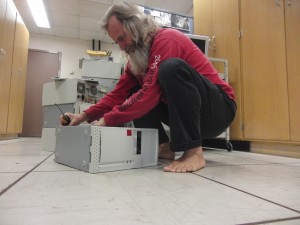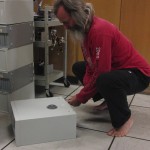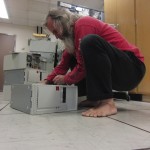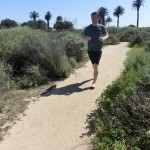Summary
Running with any degree of intensity subjects our feet to stresses that are extremely unusual. When we suffer foot problems such as plantar fasciitis, we are quick to conclude that we must be doing too much exercise and better get some rest. We might also decide that those people who regularly run more than 50 miles each week must have some super-human genetic advantage.
Plantar Fascia
The plantar fascia is a band of tough tissue that connects the front and rear of the foot, like a bowstring, supporting the arch of the foot. Plantar fasciitis, commonly known as “P.F.”, or occasionally called “heel spurs”, occurs when the plantar fascia become inflamed at the point where they attach to the heel. This inflammation causes intense pain on the inside of the heel, especially first thing in the morning, or whenever you have been sitting or lying still for a long period of time without flexing your feet.
You might expect me, as a barefoot runner, to suggest that shoes are entirely at fault. And it’s true that in societies where people go barefoot regularly, they don’t suffer foot problems that are common in modern society. However, my recent experience suggests these problems may be less related to footwear and more a factor of foot activity.
Adaptation
Recently while moving, I cut back on my time-consuming long gentle runs to allow more time for moving and associated errands. I still ran occasional short runs and even a couple of races. Soon I experienced symptoms associated with plantar fasciitis. I also felt minor pains in my left knee and right ankle (more than 30 years ago I severely sprained my left knee and 10 years ago the right ankle).
The traditional explanation for the seemingly weak plantar fascia is that, on an evolutionary scale, we only began to walk upright on two feet recently and there hasn’t been enough time for natural selection to strengthen the fascia sufficiently. Therefore, we are told, “our feet need shoes, and our arches need support!”
The traditional explanation for my pains would be something like, “they are the result of previous injuries”. Which is partially true, except when I am strong, I don’t have these pains. Only when I don’t take the time to run long and slow regularly do I have these pains. And the explanation that it is the endorphins or runner’s high that gets rid of the pain, can’t be correct, or they would disappear on my first long run, rather than gradually over time as I rebuild my strength. Secondly, they would return shortly after finishing any long run. That also is not entirely true (except after an unusually long or hard run).
And plantar fasciitis is so common and crippling that evolution would not have allowed carriers of such a design flaw to become anyone’s ancestors. Nor would evolution have allowed such minor injuries as an ankle or knee sprain to debiliate us for the rest of our lives. And they don’t, IF we get back out and walk and (gradually) run and rebuild ourselves. It’s unbelievable that our ancestors would never sprain an ankle or knee without recovering so they could walk and run without pain!
After I finished the task of moving my household, I gradually resumed my long slow runs and surprisingly the pain began to subside gradually. The more long gentle running I did, the less pain I suffered. It was as if these long slow runs were strengthening my feet and joints! And why not?
I suggest that the weakness of the plantar fascia is, not a lack of adaptation, but a result of reduced physical activity. Or perhaps it is a lack of adaptation … to sitting, especially in chairs. After all, if we support our feet, and our arches, even our bodies all day long, it’s only natural that they will become weakened (atrophy).
Randolph M. Nesse and George C. Williams in their 1994 book “Why We Get Sick” agree with me. Nesse and Williams point out that hunter-gatherers walk for several hours each day. When they aren’t walking they don’t sit in chairs, they squat.
Since exercises that stretch the plantar fascia to make it longer and more resilient seem effective in relieving that problem, it seems that regular squatting, which provides steady gentle stretching of the plantar fasciitis, could serve as a preventative measure (and of course gentle walking and running while bare foot).
More unusual than the short bursts of intense exercise we subject ourselves to, is that most of the day our feet dangle uselessly or are propped up on a stool while we sit in a chair. Perhaps inactivity is one of the most difficult aspects of the modern environment for humans to adapt to.
What to do?
What to do? Sit less, Walk more. Sit even less, squat more. Run hard less, run long and gentle more. Your intense speed runs, including races, should probably be no more than 10% of your total mileage. Since it’s tough to squeeze in time consuming long slow runs in our hectic society, I’ll make a few suggestions.
Don’t wait for elevators I often see young healthy people waiting several minutes for an elevator to take them up one or two floors. In the time they are waiting I easily run up the stairs to my office on the 5th floor.
Don’t drive or bicycle anywhere that is within a 20-minute walk. You can easily waste 5 or ten minutes looking for and walking to and from your parking space or locking up your bicycle. Might as well leave the car and bicycle at home where it is less trouble.
Move closer to work or change jobs so that you are within walking or running distance. When you do run to work, don’t race. The goal is to build up, not break down.
Spend more family time walking together. You may have to cut out some of those TV programs, but you should find communication easier while walking than during commercial breaks.
Try the suggestions that make sense for your life. If none make sense to you, think up a few of your own. While I don’t agree with the whole message of the advertisements, it is very true that sometimes we need to stop making excuses and “Just do it!”
Related Links
Gallery
- Take the opportunity to squat whenever practical
- Take the opportunity to squat whenever practical
- Take the opportunity to squat whenever practical





